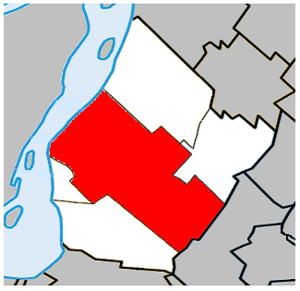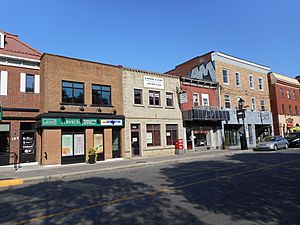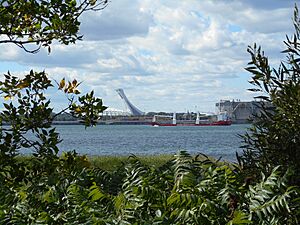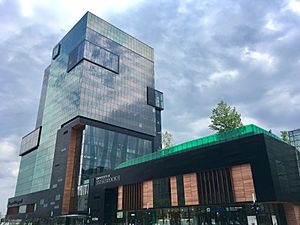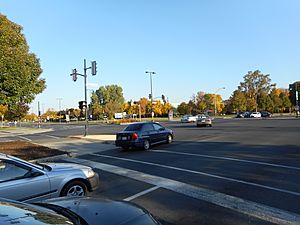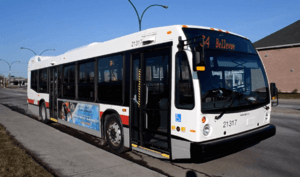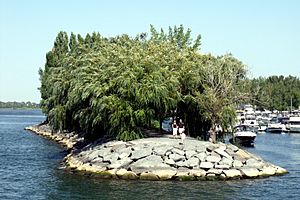Longueuil facts for kids
Quick facts for kids
Longueuil
|
|||||
|---|---|---|---|---|---|
| City of Longueuil Ville de Longueuil |
|||||
|
Clockwise from top left: City Hall, Université de Sherbrooke, rue Saint-Charles, Jacques-Cartier Bridge and downtown.
|
|||||
|
|||||
| Motto(s): | |||||
| Country | Canada | ||||
| Province | Quebec | ||||
| Region | Montérégie | ||||
| RCM | None | ||||
| Agglomeration | Longueuil | ||||
| Settled | 1657 | ||||
| Constituted | January 1, 2002 | ||||
| Boroughs |
List
Greenfield Park
Le Vieux-Longueuil Saint-Hubert |
||||
| Government | |||||
| • Type | Longueuil City Council | ||||
| Area | |||||
| • Total | 122.64 km2 (47.35 sq mi) | ||||
| • Land | 115.17 km2 (44.47 sq mi) | ||||
| • Water | 7.47 km2 (2.88 sq mi) 6.1% | ||||
| Population
(2021)
|
|||||
| • Total | 254,483 | ||||
| • Density | 2,198.2/km2 (5,693/sq mi) | ||||
| • Pop 2016–2021 | |||||
| • Dwellings | 117,006 | ||||
| Time zone | UTC−5 (EST) | ||||
| • Summer (DST) | UTC−4 (EDT) | ||||
| Postal code(s) |
J3Y, J3Z, J4G to J4N, J4T, J4V
|
||||
| Area code(s) | 450 and 579 | ||||
| Demonym | Longueuillois(e) | ||||
Longueuil (French pronunciation: [lɔ̃ɡœj]) is a big city in the province of Quebec, Canada. It's the main city of the Montérégie administrative region. Longueuil is located on the south shore of the Saint Lawrence River, right across from Montreal.
In 2021, about 254,483 people lived here. This makes Longueuil Montreal's second largest suburb. It's also the fifth biggest city in Quebec and the twentieth largest in all of Canada.
Longueuil was started in 1657 by Charles Le Moyne. Back then, it was called a seigneurie, which was like a large estate. Over time, it grew from a parish to a village, then a town, and finally a city in 1920.
The city's size changed a lot between 1961 and 2006. It merged with nearby towns and then some of them became separate cities again. Today, Longueuil is a mix of homes, shops, and factories. Many people who live here travel to Montreal for work. The city is made up of three main areas called boroughs: Le Vieux-Longueuil, Saint-Hubert, and Greenfield Park.
Longueuil is also an important legal center. People who live in Longueuil are called Longueuillois.
Contents
- Exploring Longueuil's Past: A Journey Through History
- Understanding Longueuil's Geography
- People of Longueuil: Demographics and Languages
- Longueuil's Economy: Jobs and Industries
- Arts, Culture, and Fun in Longueuil
- Getting Around: Longueuil's Transportation and Services
- Learning in Longueuil: Schools and Colleges
- Media and Communications in Longueuil
- Longueuil's Sister Cities
- Notable People from Longueuil
- Images for kids
- See also
Exploring Longueuil's Past: A Journey Through History
How Longueuil Began: From Seigneurie to City

Longueuil was founded in 1657 by a merchant named Charles Le Moyne. He came from Ville-Marie, which is now Montreal. At that time, the land in New France was divided into large estates called seigneuries. This helped protect the colony.
Charles Le Moyne named Longueuil after a village in his home region of Normandy, France. His son, Charles Le Moyne de Longueuil, later built Fort Longueuil. This fort was a strong stone house with four towers, built between 1685 and 1690.
Fort Longueuil: A Historic Landmark
During the American Revolutionary War, American troops might have used Fort Longueuil. Later, the British took it over. The fort was torn down in 1810 because it was in bad shape.
Today, you can still find the old remains of Fort Longueuil. These remains are under the Saint-Antoine-de-Padoue Cathedral. In 1923, the fort's site was named a National Historic Site of Canada.
Growing into a City: Longueuil's Development
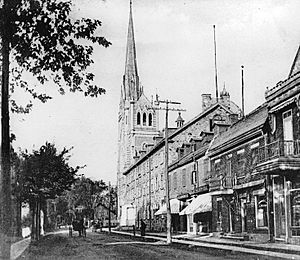
The old system of seigneuries ended in 1845. Longueuil then became a parish municipality called Saint-Antoine-de-Longueuil. In 1848, a part of this parish became the official village of Longueuil.
This village kept growing. It became a town in 1874 and then a full city in 1920. A famous musician named Paul Pratt was the city's mayor for many years, from 1935 to 1966.
Changes to City Borders: Mergers and Separations
Longueuil's city limits expanded several times. In 1961, it merged with Montréal-Sud. In 1969, it merged again with Ville Jacques-Cartier. Each time, the new, bigger city kept the name Longueuil.
On January 1, 2002, the government merged Longueuil with several other nearby cities. These included Boucherville, Brossard, and Saint-Hubert. The new, very large city was still called Longueuil.
However, some of these cities later decided to become independent again. In 2006, Boucherville, Brossard, Saint-Lambert, and Saint-Bruno-de-Montarville separated from Longueuil. So, the Longueuil we know today includes the areas that were once Longueuil (from 1969 to 2002), Saint-Hubert, Greenfield Park, and LeMoyne.
Understanding Longueuil's Geography
Where Longueuil is Located
Longueuil covers about 115.59 square kilometers (44.6 square miles) of land. It is next to Saint-Lambert on the west and Brossard to the southwest. To the northeast is Boucherville, and to the east is Saint-Bruno-de-Montarville. The Saint Lawrence River and Montreal are to the northwest.
The city is about 7 kilometers (5 miles) east of Montreal. It sits on the south shore of the Saint Lawrence River.
Longueuil's Landscape and Natural Areas
Longueuil is in the Saint Lawrence River valley, which is a large flat area called a plain. The parts of the city near the river used to be swamp land with mixed forests. Later, this land became excellent for farming. You can still see farms in the areas furthest from the river.
Longueuil also includes Île Charron, a small island in the Saint Lawrence River. This island is part of the Boucherville Islands.
Longueuil's Climate: Seasons and Weather
Longueuil has a climate similar to Montreal. It's known as a humid continental climate. This means it has long winters, usually from November to March. Spring is short, in April and May. Summers are average, from June to August, and autumn is short, in September and October.
| Climate data for Montréal/Saint-Hubert Airport (1981–2010) | |||||||||||||
|---|---|---|---|---|---|---|---|---|---|---|---|---|---|
| Month | Jan | Feb | Mar | Apr | May | Jun | Jul | Aug | Sep | Oct | Nov | Dec | Year |
| Record high humidex | 15.4 | 15.5 | 23.4 | 34.7 | 38.7 | 47.2 | 46.2 | 46.9 | 41.8 | 34.5 | 24.9 | 18.0 | 47.2 |
| Record high °C (°F) | 13.9 (57.0) |
15.3 (59.5) |
23.7 (74.7) |
30.6 (87.1) |
33.3 (91.9) |
35.0 (95.0) |
35.6 (96.1) |
35.6 (96.1) |
33.8 (92.8) |
28.9 (84.0) |
22.8 (73.0) |
17.1 (62.8) |
35.6 (96.1) |
| Mean daily maximum °C (°F) | −5.6 (21.9) |
−3.2 (26.2) |
2.3 (36.1) |
11.3 (52.3) |
19.1 (66.4) |
23.8 (74.8) |
26.3 (79.3) |
25.4 (77.7) |
20.5 (68.9) |
13.0 (55.4) |
5.6 (42.1) |
−1.5 (29.3) |
11.4 (52.5) |
| Daily mean °C (°F) | −10.4 (13.3) |
−8.2 (17.2) |
−2.5 (27.5) |
5.7 (42.3) |
12.9 (55.2) |
17.9 (64.2) |
20.6 (69.1) |
19.5 (67.1) |
14.7 (58.5) |
7.9 (46.2) |
1.5 (34.7) |
−5.8 (21.6) |
6.2 (43.1) |
| Mean daily minimum °C (°F) | −15.1 (4.8) |
−13.1 (8.4) |
−7.3 (18.9) |
0.1 (32.2) |
6.7 (44.1) |
11.9 (53.4) |
14.8 (58.6) |
13.6 (56.5) |
8.8 (47.8) |
2.7 (36.9) |
−2.6 (27.3) |
−10.1 (13.8) |
0.9 (33.6) |
| Record low °C (°F) | −36.1 (−33.0) |
−37.2 (−35.0) |
−36.1 (−33.0) |
−15.0 (5.0) |
−4.4 (24.1) |
0.0 (32.0) |
4.9 (40.8) |
1.7 (35.1) |
−4.9 (23.2) |
−8.9 (16.0) |
−22.8 (−9.0) |
−37.2 (−35.0) |
−37.2 (−35.0) |
| Record low wind chill | −49.0 | −46.0 | −40.0 | −26.0 | −10.0 | 0 | 0 | 0 | −6.0 | −14.0 | −30.0 | −45.0 | −49.0 |
| Average precipitation mm (inches) | 75.8 (2.98) |
61.9 (2.44) |
71.6 (2.82) |
82.7 (3.26) |
81.7 (3.22) |
87.3 (3.44) |
96.8 (3.81) |
88.3 (3.48) |
84.5 (3.33) |
87.0 (3.43) |
104.3 (4.11) |
88.8 (3.50) |
1,010.7 (39.82) |
| Average rainfall mm (inches) | 26.4 (1.04) |
22.8 (0.90) |
33.9 (1.33) |
67.8 (2.67) |
81.5 (3.21) |
97.3 (3.83) |
96.8 (3.81) |
88.3 (3.48) |
84.5 (3.33) |
85.3 (3.36) |
84.4 (3.32) |
39.4 (1.55) |
808.4 (31.83) |
| Average snowfall cm (inches) | 52.0 (20.5) |
39.0 (15.4) |
36.5 (14.4) |
13.4 (5.3) |
0.2 (0.1) |
0 (0) |
0 (0) |
0 (0) |
0 (0) |
1.4 (0.6) |
18.0 (7.1) |
48.8 (19.2) |
209.3 (82.6) |
| Average precipitation days (≥ 0.2 mm) | 17.4 | 13.8 | 14.2 | 13.4 | 13.7 | 12.4 | 12.4 | 11.5 | 10.8 | 13.1 | 15.6 | 16.3 | 164.6 |
| Average rainy days (≥ 0.2 mm) | 4.5 | 4.5 | 7.5 | 11.7 | 13.7 | 12.2 | 12.3 | 11.5 | 10.8 | 12.7 | 12.3 | 6.0 | 119.7 |
| Average snowy days (≥ 0.2 cm) | 15.4 | 11.8 | 9.3 | 3.5 | 0.14 | 0 | 0 | 0 | 0 | 0.74 | 5.7 | 12.9 | 59.48 |
| Source: Environment Canada | |||||||||||||
People of Longueuil: Demographics and Languages
Population Growth Over Time
| Longueuil | ||
|---|---|---|
| Year | Pop. | ±% |
| 1851 | 1,496 | — |
| 1861 | 2,816 | +88.2% |
| 1871 | 2,083 | −26.0% |
| 1881 | 2,355 | +13.1% |
| 1891 | 2,757 | +17.1% |
| 1901 | 2,835 | +2.8% |
| 1911 | 3,972 | +40.1% |
| 1921 | 4,682 | +17.9% |
| 1931 | 5,407 | +15.5% |
| 1941 | 7,087 | +31.1% |
| 1951 | 11,103 | +56.7% |
| 1956 | 14,332 | +29.1% |
| 1961 | 24,131 | +68.4% |
| 1966 | 25,593 | +6.1% |
| 1971 | 97,590 | +281.3% |
| 1976 | 122,429 | +25.5% |
| 1981 | 124,320 | +1.5% |
| 1986 | 125,441 | +0.9% |
| 1991 | 129,808 | +3.5% |
| 1996 | 127,977 | −1.4% |
| 2001 | 128,016 | +0.0% |
| 2006 | 229,230 | +79.1% |
| 2011 | 231,409 | +1.0% |
| 2016 | 239,700 | +3.6% |
| 2021 | 254,483 | +6.2% |
|
|||||||||||||||||||||||||||||||||||||||||||||||||||||||||||||||||||||||||||
In 2021, Longueuil had a population of 254,483 people. They lived in 113,086 homes. This was a 6.1% increase from 2016. The city covers about 115.77 square kilometers. This means there were about 2,198 people per square kilometer in 2021.
| Canada census – Longueuil community profile | |||
|---|---|---|---|
| 2016 | 2011 | ||
| Population: | 239,700 (+3.6% from 2011) | 231,409 (+0.9% from 2006) | |
| Land area: | 115,785 km2 (44,705 sq mi) | 115.59 km2 (44.63 sq mi) | |
| Population density: | 2,070.9/km2 (5,364/sq mi) | 2,002.0/km2 (5,185/sq mi) | |
| Median age: | 41.9 (M: 40.7, F: 43.4) | 41.9 (M: 40.4, F: 43.5) | |
| Total private dwellings: | 110,761 | 106,499 | |
| Median household income: | $58,626 | $58,317 | |
| References: 2016 2011 earlier | |||
The average income for workers in Longueuil was $36,400. This is a bit higher than the average for all of Quebec. For people working full-time, the average income was $58,000.
Languages Spoken in Longueuil
In 2021, French was the main language spoken at home for 71.9% of Longueuil's residents. English was the main language for 5.8%. Many other languages are also spoken in the city. The most common ones include Spanish, Arabic, and Romanian.
| Canada Census Mother Tongue - Longueuil, Quebec | ||||||||||||||||||
|---|---|---|---|---|---|---|---|---|---|---|---|---|---|---|---|---|---|---|
| Census | Total |
|
|
|
|
|||||||||||||
| Year | Responses | Count | Trend | Pop % | Count | Trend | Pop % | Count | Trend | Pop % | Count | Trend | Pop % | |||||
|
|
|
181,075 | 71.9% | 14,565 | 5.8% | 4,460 | 1.8% | 44,810 | 17.8% | |||||||||
|
|
|
182,705 | 76.9% | 13,900 | 5.8% | 2,485 | 1.0% | 34,310 | 14.4% | |||||||||
|
|
|
181,800 | 79.2% | 14,155 | 6.2% | 2,460 | 1.1% | 28,115 | 12.3% | |||||||||
|
|
|
181,790 | 80.2% | 15,395 | 6.8% | 1,795 | 0.8% | 27,845 | 12.3% | |||||||||
|
|
|
184,380 | 84.3% | 13,885 | 6.4% | 1,880 | 0.9% | 17,795 | 8.1% | |||||||||
|
|
|
183,065 | n/a | 83.0% | 16,775 | n/a | 7.6% | 2,285 | n/a | 1.0% | 16,795 | n/a | 7.6% | |||||
| Top 20 languages Longueuil, 2021 | Population | % |
|---|---|---|
| French | 181,075 | 71.9 |
| English | 14,565 | 5.8 |
| Spanish | 11,300 | 4.5 |
| Arabic | 7,230 | 2.9 |
| Romanian | 2,235 | 0.9 |
| Haitian Creole | 2,195 | 0.9 |
| Portuguese | 1,950 | 0.8 |
| Mandarin | 1,910 | 0.8 |
| Russian | 1,800 | 0.7 |
| Dari | 1,660 | 0.7 |
| Kabyle | 1,115 | 0.4 |
| Vietnamese | 1,065 | 0.4 |
| Yue | 1,005 | 0.4 |
| Italian | 985 | 0.4 |
| Iranian Persian | 640 | 0.3 |
| Creole | 490 | 0.2 |
| Greek | 485 | 0.2 |
| Wolof | 395 | 0.2 |
| Morisyen | 375 | 0.1 |
| Bulgarian | 280 | 0.1 |
Diverse Ethnic Backgrounds
| Ethnic Origin | Population | Percent |
|---|---|---|
| Canadian | 60,585 | 24.2% |
| French | 54,350 | 21.7% |
| Québécois | 27,500 | 11% |
| French Canadian | 14,095 | 5.6% |
| Irish | 11,950 | 4.8% |
| Haitian | 8,780 | 3.5% |
| Italian | 7,930 | 3.2% |
| Scottish | 5,380 | 2.1% |
| English | 4,825 | 1.9% |
| Arab | 4,805 | 1.9% |
| Chinese | 4,710 | 1.9% |
| African | 4,425 | 1.7% |
| First Nations | 3,830 | 1.5% |
In 2021, people of European backgrounds made up 73.4% of Longueuil's population. The largest groups from other backgrounds include Black people (9.9%), Latin American people (4.6%), and Arab people (4.4%).
| Panethnic group |
2021 | 2016 | 2011 | 2006 | 2001 | |||||||||
|---|---|---|---|---|---|---|---|---|---|---|---|---|---|---|
| Pop. | % | Pop. | % | Pop. | % | Pop. | % | Pop. | % | |||||
| European | 183,935 | 73.45% | 188,900 | 80.4% | 193,360 | 84.82% | 198,620 | 87.57% | 116,660 | 92.03% | ||||
| African | 24,910 | 9.95% | 16,510 | 7.03% | 10,500 | 4.61% | 9,230 | 4.07% | 3,520 | 2.78% | ||||
| Middle Eastern | 13,880 | 5.54% | 9,360 | 3.98% | 6,565 | 2.88% | 4,750 | 2.09% | 1,865 | 1.47% | ||||
| Latin American | 11,400 | 4.55% | 7,355 | 3.13% | 5,810 | 2.55% | 4,580 | 2.02% | 1,205 | 0.95% | ||||
| East Asian | 4,870 | 1.94% | 3,700 | 1.57% | 3,235 | 1.42% | 3,030 | 1.34% | 1,070 | 0.84% | ||||
| Southeast Asian | 3,550 | 1.42% | 3,100 | 1.32% | 3,085 | 1.35% | 2,865 | 1.26% | 1,280 | 1.01% | ||||
| Indigenous | 3,255 | 1.3% | 2,440 | 1.04% | 2,230 | 0.98% | 1,360 | 0.6% | 420 | 0.33% | ||||
| South Asian | 2,605 | 1.04% | 1,895 | 0.81% | 2,085 | 0.91% | 1,610 | 0.71% | 480 | 0.38% | ||||
| Other/Multiracial | 2,035 | 0.81% | 1,690 | 0.72% | 1,105 | 0.48% | 770 | 0.34% | 265 | 0.21% | ||||
| Total responses | 250,430 | 98.41% | 234,955 | 98.02% | 227,970 | 98.51% | 226,820 | 98.91% | 126,760 | 99.02% | ||||
| Total population | 254,483 | 100% | 239,700 | 100% | 231,409 | 100% | 229,330 | 100% | 128,016 | 100% | ||||
| Note: Totals greater than 100% due to multiple origin responses | ||||||||||||||
Longueuil's Economy: Jobs and Industries
Even though many Longueuil residents work in Montreal, the city itself has many jobs. These jobs are in different types of businesses. Longueuil is a good place for businesses because land and buildings are not too expensive. This is true even though it's close to Montreal.
Key Industries in Longueuil
Longueuil is especially strong in the aerospace industry. This means companies that build things for airplanes and space. Two big companies, Pratt & Whitney Canada and Héroux-Devtek, have their main offices here. Pratt & Whitney Canada is the biggest employer in Longueuil, with 5,000 workers. Héroux-Devtek has 550 employees.
The main office of the Canadian Space Agency is also in Longueuil. It's located near the Montréal/Saint-Hubert Airport. Pascan Aviation, an airline, also has its main office in Saint-Hubert, Longueuil. Other companies in Longueuil include Agropur, a dairy company, and Hasbro, a toy company.
In 2008, a magazine called Canadian Business said Longueuil was the 30th best place to do business in Canada.
Arts, Culture, and Fun in Longueuil
Festivals and Events
Longueuil hosts the Longueuil International Percussion Festival. This festival happens for six days in July in the Old Longueuil area. It features 500 musicians and attracts 200,000 visitors every year.
Parks and Green Spaces
Longueuil has three nature parks where you can enjoy the outdoors. These are Parc Marie-Victorin and Parc Michel-Chartrand in Le Vieux-Longueuil. There's also Parc de la Cité in Saint-Hubert. The city also has a wildlife reserve called the Boisé du Tremblay. Part of this reserve is in Le Vieux-Longueuil and part is in Boucherville.
Sports Facilities and Teams
There are seven arenas in Longueuil for sports like ice hockey. These include Cynthia Coull Arena in Greenfield Park and Colisée Jean Béliveau in Le Vieux-Longueuil.
Longueuil is home to several sports teams. These include the Collège Édouard-Montpetit Lynx for women's ice hockey and CS Longueuil for soccer. The city also has the Le Collège Français de Longueuil for ice hockey and the Longueuil Ducs for baseball.
| Team | Sport | League | Venue |
|---|---|---|---|
| Collège Édouard-Montpetit Lynx | Women's ice hockey | Hockey collégial féminin RSEQ | Aréna Émile Butch Bouchard |
| CS Longueuil | Soccer | Première ligue de soccer du Québec | Centre Multi-Sport |
| Le Collège Français de Longueuil | Ice hockey | Quebec Junior AAA Hockey League | Colisée Jean Béliveau |
| Longueuil Ducs | Baseball | Ligue de Baseball Élite du Québec | Parc Paul-Pratt |
| South Shore JR Bruizers | Canadian football | Quebec Junior Football League | Parc Rosanne Laflamme |
Places of Worship
Important places of worship in Longueuil include the Roman Catholic Co-Cathedral of Saint-Antoine-de-Padoue. There's also the Église Nouvelle vie evangelical church and the Montréal Québec Temple of the Church of Jesus Christ of Latter-day Saints.
Getting Around: Longueuil's Transportation and Services
Daily Commutes and Travel
Many people who live in Longueuil travel to Montreal for work every day. About 39,485 residents commute to Montreal. Only slightly fewer, about 38,090 residents, work within Longueuil itself. Some people also commute to nearby cities like Boucherville and Brossard.
Fewer people travel from Montreal to work in Longueuil. Also, people from other nearby cities like Brossard and Boucherville commute to Longueuil for work.
Roads and Bridges
There are only five ways to cross the Saint Lawrence River by car between Montreal Island and the south shore. Two of these are in Longueuil. These are the Louis Hippolyte Lafontaine Tunnel and the Jacques Cartier Bridge.
Autoroute 20 is a major highway in Longueuil. It runs along the Saint Lawrence River. Autoroute 30 crosses the Saint-Hubert area in the southern part of the city.
Route 134 is another important road. It's also known as the Jacques Cartier Bridge and Taschereau Boulevard. This road connects the bridge to all three boroughs of Longueuil.
Public Transportation Options
The Réseau de transport de Longueuil (RTL) provides bus service in Longueuil. They have 80 bus routes and 12 shared taxi routes. In 2022, about 18 million passengers used these services. Most bus lines end at the Longueuil Bus Terminus.
The city also has a Metro station called Longueuil–Université-de-Sherbrooke. This station connects to downtown Montreal using the Yellow Line. There's also a commuter train line, the Mont-Saint-Hilaire line. The only commuter train station in Longueuil is Longueuil–Saint-Hubert station.
Longueuil has a small airport called Saint-Hubert Airport. It's one of Canada's busiest airports for smaller planes.
There's also a small marina called the Réal-Bouvier Marina on the Saint Lawrence River. A seasonal ferry service connects this marina to the Old Port of Montreal.
Hospitals and Healthcare
Longueuil has two hospitals that serve its residents. The Charles-LeMoyne Hospital is in Greenfield Park. It's the main hospital for Longueuil and nearby cities. The Pierre-Boucher Hospital is a smaller hospital in Le Vieux-Longueuil. It serves that area and several other towns.
Learning in Longueuil: Schools and Colleges
Longueuil has many schools and colleges. Both the Université de Sherbrooke and Université de Montréal have campuses in Le Vieux-Longueuil.
There is one CEGEP (a type of college in Quebec) in Longueuil, called Collège Édouard-Montpetit. It's in Le Vieux-Longueuil. This college also has a special school for airplane technology, the École nationale d'aérotechnique. It's located in Saint-Hubert, near the airport.
There are also two technical and professional colleges in Le Vieux-Longueuil. These are the Pierre-Dupuy Professional Formation Centre and Collège Info-Technique.
Primary and Secondary Schools
For public English-speaking students, schools are run by the Riverside School Board. Longueuil has three secondary (high) schools from this board: Centennial Regional High School in Greenfield Park, Heritage Regional High School in Saint-Hubert, and Saint-Lambert International High School in Saint-Lambert.
Public French-speaking schools are run by the Commission scolaire Marie-Victorin. There are seven secondary schools in Longueuil from this district. These include École secondaire Internationale St-Edmond in Greenfield Park and École secondaire Gérard-Filion in Le Vieux-Longueuil.
There are also three private French secondary schools in Le Vieux-Longueuil. They are Collège Charles-Lemoyne, Collège Français, and Collège Notre-Dame-de-Lourdes.
Media and Communications in Longueuil
Longueuil has two free weekly French-language newspapers. Le Courrier du Sud is the oldest, and Rive-Sud Express is newer. Both are delivered to homes and available in newspaper boxes. There's also a free monthly newspaper called Point Sud.
Longueuil also has a local radio station, CHAA-FM 103.3. Another radio station, CHMP-FM 98.5, is officially based in Longueuil. Residents can also watch a local cable television station called Télé Rive-Sud (TVRS).
Longueuil's Sister Cities
Longueuil has special connections with other cities around the world. These are called "sister cities" or "twin towns."
 Lafayette, Louisiana, United States
Lafayette, Louisiana, United States Whitby, Ontario, Canada
Whitby, Ontario, Canada
Notable People from Longueuil
Many interesting people have come from Longueuil, including:
- Maxime Comtois, an ice hockey player
- Jon Lajoie, a comedian
- Anthony Mantha, an ice hockey player
- Émilien Néron, an actor
- Lysianne Proulx, a soccer player for Canada
- Abraham Toro, a baseball player
Images for kids
See also
 In Spanish: Longueuil para niños
In Spanish: Longueuil para niños










